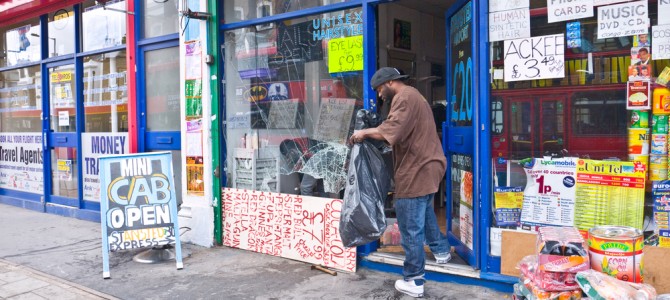
Three days after 9/11, Krugtron the Invincible wrote the most Paul Krugman post ever discussing the potential benefits, primarily economic, of the terror attacks. In the wake of the destruction in Maryland, I’m now eagerly awaiting his column praising all the economic stimulus going on in Baltimore this week. Krugtron, wholly rapt by the fallacy of the broken window, is sure not to disappoint on this front. It’s his thing.
The fallacy of the broken window was introduced by Frenchman Frédéric Bastiat in “That Which is Seen, and That Which is Not Seen” in 1850. The parable, titled simply “The Broken Window,” was a short tale dealing with opportunity cost, one of Bastiat’s focal points. In the parable, shopkeeper James B. discovers his window is broken and must be replaced, thereby keeping the window glazier in business. Many saw this is as a net good. Window glaziers need work, too.
What Bastiat highlighted was that the six francs James B. spent repairing his window—that which is seen—does not account for the other ways that James B. might have spent those six francs—that which is unseen. It’s true that the glazier does not profit from James B.’s shoe purchase, his preferred use of his six francs, but James B. certainly enjoys having both new shoes and a window.
Bastiat pointed out that this combination—getting new shoes and keeping his window—was preferable to giving the window glazier six francs. In Bastiat’s own words, aimed at trade protectionists, “What will you say, Monsieur Industriel—what will you say, disciples of good M. F. Chamans, who has calculated with so much precision how much trade would gain by the burning of Paris, from the number of houses it would be necessary to rebuild?”
Today we aren’t discussing the burning of Paris, but of Baltimore. The chaos in the city, not so much in the news on Saturday because of more pressing concerns, finally made its way to the wider populace on Monday when the riots and looting exploded. As of Tuesday, Baltimore had calmed and the reports about the number of broken windows began to roll in.
How the Baltimore Riots Started
Before we get to Bastiat and Baltimore, we have to examine where it all began. David Graham, writing at The Atlantic, covers the story of Freddie Gray in detail (at least, as much detail as is available). Gray was arrested on April 12 for unknown reasons. He died on April 19 from spinal injuries. Although struggling to walk when arrested, likely from a leg injury sustained during a chase, the injuries that killed him occurred while in police custody. Experts compared them to those that occur during a major car crash.
This wasn’t the first time an individual came out of a Baltimore police van in much worse shape than he or she went in. Baltimore police seem to employ an unsanctioned technique known as the “rough ride,” and the city has paid multiple settlements to people who suffered spinal injuries while in police custody.
As such, we have a death very similar to those of Eric Garner and Walter Scott—a black man confronted for a trivial reason and who ended up losing his life to out-of-control police officers. The anger here is extremely justified.
From Protest to Fire
The anger moved above the surface over the weekend. It started on Saturday with a protest march. However, the situation quickly escalated into destruction with 34 people being arrested on that first night. The violence necessitated a message asking attendees of an Orioles game to remain in the stadium. Unfortunately, tension remained high through Sunday and Monday. By Tuesday, 15 buildings and 144 cars had been set on fire and 233 people arrested.
That’s a lot of broken windows, especially at this under-construction senior center that was to house approximately 60 low-income seniors and a community center. So while the anger about police behavior may be justified, the way people expressed it is not. Seriously, people. Stop arguing that burning and looting are understandable. Unless you want to offer up your address so people can take the show on the road.
The Economic Case against Riots
As it stands, the residents of Baltimore will not benefit from these riots. Gray’s family has vocally condemned the riots, with his mother saying, “Don’t tear up the whole city just for him. That’s wrong.” Maybe she should have tried quoting Bastiat. For though the flames are currently extinguished, Baltimore is facing long-term economic consequences as a result of the riots.
Joe Carter points out a number of significant challenges Baltimore residents face as a result of the riots:
In 2004, the National Bureau of Economic Research (NBER) published two papers that examined the effect of the riots in the 1960s and early 1970s. From 1964 to 1971, as many as 700 riots erupted in cities across America. The large numbers of injuries, deaths, property damage that occurred in predominantly black neighborhoods caused considerable short-term damage on the communities. But the impact over the long run (from 1960 to 1980) was even more severe.
Later, in the same article, Carter breaks another pane in the broken window fallacy:
They find that the riots significantly depressed the median value of black-owned property between 1960 and 1970, with little or no rebound in the 1970s. The baseline estimates for severe-riot cities relative to small-or-no-riot cities range from approximately 14 to 20 percent for black-owned properties, and from 6 to 10 percent for all central-city residential properties. Household-level data for the 1970s indicate that the racial gap in property values widened substantially in riot-afflicted cities relative to others.
So Many Broken Windows
Piles of broken glass. Stores damaged and looted. A brick thrown through the window of a music store. Police cars and a CVS Pharmacy set ablaze. Gang members uniting to guard black-owned businesses in an attempt to stop the destruction.
As of writing, rioting has been replaced by restoration. Volunteers are working to clean the damages and return a sense of normalcy to the city. They’re not being paid six francs.
No, Baltimore will reel from the past few days for years to come. Some businesses will never reopen. Some will take time. Money that may have been spent on expanding, new employees, or a new pair of shoes will now go to windows, doors, and ceilings. Remember our friend, opportunity cost? For Baltimore, opportunity costs are going to be steep.
In Krugman’s post-9/11 piece, he stated, “First, the driving force behind the economic slowdown has been a plunge in business investment. Now, all of a sudden, we need some new office buildings.” Baltimore will definitely need some new buildings. One problem is that its economy was actually ahead of the national average. It wasn’t in need of new buildings, outside of that destroyed senior center. The bigger problem is that the destruction of property doesn’t function as Shiva the Destroyer, razing neighborhoods so that the world can be made anew. No, broken windows are just broken windows; “destruction cannot be the source of prosperity.”
The Answer to Tragedy Isn’t Tragedy
Gray’s death is a tragedy. The events of the past few days, though equally senseless, are not as tragic. A building is not the same as a life. However, those whose response to tragedy was to burn and loot the businesses of their neighbors, while giving some new work to window glaziers, will not solve anything. For, as Bastiat said, “Life, liberty, and property do not exist because men have made laws. On the contrary, it was the fact that life, liberty, and property existed beforehand that caused men to make laws in the first place.”
The men charged with enforcing the law violated their end of the contract. But that does not negate what predated the contract, it makes it imperative to renew the contract and burn down those who use it as an excuse to ignore those initial conditions. Buildings will be restored, businesses re-opened. They will do so not because rioters held life, liberty, and property hostage, because they destroyed it. They will move on in spite of it, but they’ll be forced to do so at a slower pace.









